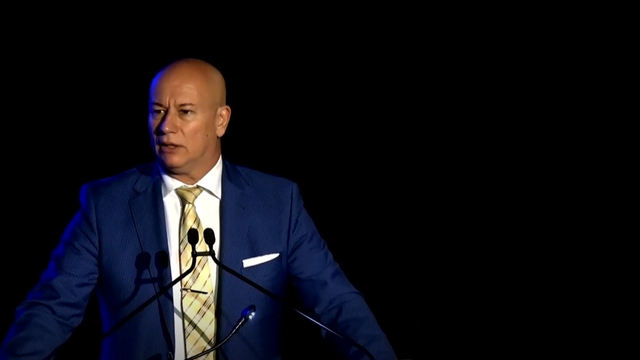

Ahead of the launch of Public Sector Network's Research Innovation Council, a new forum engineered to achieve a structured, impactful approach to partnering for innovation, I am pleased to release our findings and report on the "State of the Australian Innovation System", outlining the inspiration and purpose for deploying such an ambitious initiative.
Our latest program addresses the barriers and resolutions identified within this article, offering senior executives a unique opportunity to gather monthly for research-driven roundtables with colleagues, academics, and technologists. Together, we will discuss trends, challenges and opportunities in technology, innovation and the modernisation of government services.
This only scratches the surface, with esteemed Academic & Research Partners plus Industry Trailblazers set to be announced shortly, who will not only contribute to individual sessions but also research briefs published from the meetings and shared with members via a private online knowledge exchange.
State of the Australian Innovation System 2024
This report will dive into:
- National & Global findings shedding light on Australia's capacity for government-led research, innovation and collaboration as it benchmarks with international standards.
- Investigating and verifying the primary challenges inhibiting the establishment of cross-sector partnership as an enabler of research and innovation outcomes.
- Recommendations and capabilities Public Sector, Industry and Academia will need to jointly pursue in order to accelerate progress and catch up to the world stage.

Credit: Australian Connectivity Showcase 2024
The Australian Government Department of Education's Research Commercialisation Action Plan turned 2 years old earlier this year. The following is a recap of many of the issues we are still grappling with today, and perhaps even some items which are at risk or have already dropped out of focus.
Academic Institutions have been Poor at Commercialising Research
- Commercial outcomes do not match research performance: Australia performs well in knowledge creation, with 85% of research rated at or above world standard, but underperforms in achieving commercialisation outcomes.
- Low innovation novelty: Only 11% of ‘product innovative’ firms in Australia introduced new-to-market innovations, indicating a tendency towards incremental innovation rather than groundbreaking innovation.
- Incentives misaligned: Most university incentives emphasize research publications and citations over commercialisation and practical research outputs.
- Limited commercialisation of research: The Australian research system's outputs are not sufficiently translated into new products or innovations, limiting the economic impact and return on investment from publicly funded research.
- Focus on foundational research: Australian universities undertake most of the basic research (90% of pure basic research), while business investment is skewed towards later stages of research.
- A culture and skills gap has been left largely unaddressed by universities to develop commercialisation capabilities among researchers.

Credit: Australian Innovation System Monitor- Office of the Chief Economist
Collaboration between Sectors is Poor by International Standards
- Low industry-university collaboration: Australia ranks low in business collaboration on innovation with higher education or government institutions, being last in the OECD for such collaborations.
- Geographical and cultural barriers: Differences in values, priorities, and geographical distances between universities and businesses hinder effective collaboration. Businesses report difficulties engaging with universities due to cultural differences and skill set mismatches.
- Low researcher mobility: The proportion of researchers in private industry is low, and researcher mobility between industry and academia is limited, which reduces collaboration opportunities.
- International comparison: Metrics show Australia lags behind leading nations like the US, Canada, and the UK in terms of research, translation, and commercial outcomes.
Source: Research Commercialisation Action Plan (2022)

Supporting Innovation: Inhibitors to Research Collaboration
Department of Industry, Science & Resources' last Australian Innovation System Report was published in 2017, subsumed by the Australian innovation system monitor launched at the end of 2021.
Industry financing of R&D in higher education and government in Australia is average by OECD standards. Australia was ranked 16th out of 33 countries in 2012 for share in total HERD [Higher Ed Expenditure on R&D], and 12th out of 34 countries for GOVERD [Gov Expenditure on R&D] financing. In 2014–15, only three per cent of Australian businesses reported sourcing their ideas for innovation from higher education institutions. This suggests that the majority of Australian businesses are largely disconnected from the publicly funded research sector.
Source: Australian Innovation System Report (2016)
 Credit: Australian Innovation System Monitor- Office of the Chief Economist
Credit: Australian Innovation System Monitor- Office of the Chief Economist
Measuring the Future of Collaboration
Despite this diagnosis of disconnection, the latest sources of government data from the Australian Bureau of Statistics continues to focus on this expenditure on R&D dynamic.
Positively, the latest June 2024 release from the ABS does in fact reveal a positive increase of funding by Australian government organisations in 2022-23 to $4,344 million, up $726 million compared to 2020-21.
Yet concerningly since 2016, whilst specific reform initiatives from the 2022 Research Commercialisation Action Plan have indeed progressed national priorities of new funding and fellowship schemes, it is hard to ascertain the latest measures of collaboration between academic research, public sector and industry within Australia's Innovation System, and our progress since Australia ranked 29th and 30th out of 30 OECD countries for collaboration between industry, higher education and public research institutions on innovation.
"Networking and collaboration activity is essential to a high-performing innovation system"- Australian Innovation System Report (2016)- Office of the Chief Economist
 Credit: Australian Innovation System Monitor- Office of the Chief Economist
Credit: Australian Innovation System Monitor- Office of the Chief Economist
5 Roadblocks: Why Does Public Sector Struggle with the Partnership Imperative?
Public sector agencies globally are striving to forge partnerships with academics and industry as part of a broader commitment to engage with innovators at the forefront of cutting-edge developments. However, several challenges impede the establishment of these valuable interdisciplinary and cross-sector collaborations:

1. Difficulty in Identifying the Right Partners:
While the benefits of interdisciplinary partnerships are well-known, finding the right academic partners remains a significant challenge. Public sector organisations often struggle to discover researchers whose expertise aligns with their specific needs, leading to missed opportunities for collaboration.
2. Limited Visibility and Access to Research:
Academia holds a vast reservoir of knowledge and research, but public sector entities often lack visibility into this resource. The difficulty in locating relevant academic expertise hampers the ability to leverage research that could drive policy development and service improvement.
3. Administrative Burdens (Red Tape):
The process of establishing partnerships is often bogged down by administrative hurdles. These burdens can deter both public sector agencies and academic institutions from pursuing collaborative efforts, slowing down the pace at which meaningful partnerships can be formed.
4. Lack of Continuous Knowledge Sharing Mechanisms:
There are limited mechanisms in place for ongoing knowledge sharing between the public sector and academia. This gap restricts the continuous exchange of insights and innovations, which is crucial for addressing complex and evolving challenges.
5. Practical Integration of Academic Research and Partners:
Potential partnerships can often be hampered by cultural differences including differences in timeframes, focus on publications by universities, undervaluation of researchers by industry, and lack of knowledge among researchers about translating research to practical applications.
8 Mechanisms: How Are Leading Public Sector Executives Connecting with the Cutting-Edge?
Through our extensive consultation with both government & research entities, we have defined the major strategic steps and actions public sector leaders need to undertake to address roadblocks hindering effective public sector innovation partnerships.
1. Develop Strategic Engagement Channels:
Establishing dedicated channels for engagement with academic leaders ensures that the right expertise is matched with public sector needs. This can involve creating forums, workshops, and collaborative platforms that facilitate direct interaction and knowledge exchange.
2. Enhance Visibility and Access to Academic Resources:
Implementing systems to increase visibility into academic research and resources is crucial. This can be achieved through the creation of databases, partnerships with academic institutions, and participation in academic conferences and seminars to identify relevant experts and research.
3. Streamline Administrative Processes:
Simplifying and streamlining administrative procedures to facilitate easier formation of partnerships reduces bureaucratic red tape and creates standardised processes for collaboration to make it more appealing and feasible for both parties to engage.
4. Establish Continuous Knowledge Sharing Mechanisms:
Creating mechanisms for ongoing knowledge sharing between the public sector and academia includes setting up regular meetings, joint publications, shared digital platforms, and continuous feedback loops to ensure a steady flow of information and ideas.
5. Align Research with Policy Needs:
Encouraging academics to focus on applied research with immediate policy implications involves clearly communicating the public sector’s needs and priorities to academic institutions, ensuring that research efforts are directed towards practical and actionable outcomes.
6. Foster Real-World Projects and Focus Groups:
Engaging in real-world projects and focus groups that involve both public sector and academic participants fosters direct involvement that enables practical application of academic insights, fostering meaningful improvements in public policy and societal change.
7. Leverage High-Visibility Platforms:
Utilising high-visibility platforms such as conferences, workshops, and seminars to connect with top-tier academic minds provides sterling event opportunities for public sector leaders to showcase their challenges and invite academic collaboration.
8. Encourage Expert Engagement:
Promoting regular interaction with subject matter experts from academia and industry includes inviting experts to participate in public sector initiatives, offering advisory roles, and facilitating direct consultations to tap into their specialised knowledge.
By adopting these strategies, public sector leaders can effectively overcome the challenges of forming partnerships with academia. These actions will pave the way for innovative solutions, informed policy-making, and the modernisation of government services, ultimately benefiting society as a whole.
At Public Sector Network, we remain optimistic about the Future of Research, Collaboration and Partnership within Australia's Innovation Ecosystem.
.png)
The Research Innovation Council stands as a testament to our unwavering commitment to bridging the gap between public sector needs and academic excellence. By leveraging our global network and unparalleled platform, we aim to foster a culture of continuous collaboration and innovation.
This initiative not only addresses the pressing challenges of today but also paves the way for a future where government services are more responsive, efficient, and impactful.
We invite all forward-thinking leaders, researchers, and industry experts to join us in this transformative journey. Together, we can unlock the full potential of our collective expertise and drive meaningful change across the public sector.
Discover more about the Research Innovation Council and how you can contribute:
For Government: https://share.hsforms.com/1449ekykOQHCUYhrOcdfQ5A42foh
For Academia: https://share.hsforms.com/19AkwOcXDRbuQSc17eIpu9g42foh
For Industry: https://share.hsforms.com/1lSBHUm3VQ1qeFXj6vICcZg42foh


































